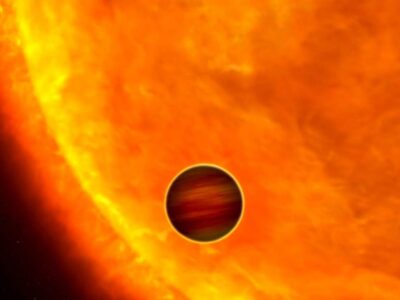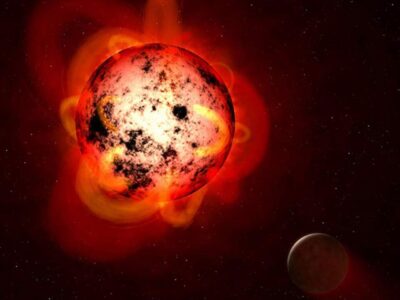The European Southern Observatory (ESO) Veritably Large Telescope (VLT) has been searching the welkin for exoplanets, stars, and black holes for a veritably long time. Lately, the VLT was used to image a earth ringing a double star system called b Centauri (via ESO). One of the more intriguing aspects of the b Centauri system is that it can be seen with the naked eye. Another intriguing aspect of the b Centauri system is that it’s the hottest and most massive earth-hosting star system so far.
The exoplanet ringing the double system circles its stars at a distance 100 times further down than Jupiter orbits the sun. Until discovering this exoplanet, some astronomers believed globes could n’t live around stars as massive as the b Centauri brace. Speaking with the ESO ( linked over), Astronomer Marcus Janson from Stockholm University, Sweden, says that discovering a earth around b Centauri is veritably instigative because it fully changes opinions about massive stars as earth hosts.
The star system b Centauri is in the constellation Centaurus about 325 light- times down from Earth. The double system is at least six times as massive as the sun, making it by far the most massive star system to host a verified earth. The discovery marks the first time a earth has been discovered ringing a star system any further than three times as massive as the sun. The exoplanet in the system is called b Centauri (AB) or Centauri b for short.
Massive star systems do n’t generally have globes because large stars are veritably hot, causing material around the star to dematerialize snappily. The main star in a double system similar as we ’re seeing then’s a B- type star, a star with a face three times hotter than our Sun.
Since the star produces so important heat, it also emits lots of ultraviolet andx-ray radiation. Massive stars similar as this would explosively impact the gas that surrounds them, which scientists believe would work against planetary conformation. Despite that belief, the earth ringing the stars has been verified.
Janson says that since B- type stars have destructive and dangerous surroundings around them, it was believed that it would be delicate for large globes to form around them. The discovery of Centauri b shows that globes can form around B- type stars despite the harsh terrain. The terrain of the earth ringing the stars would be nothing like the terrain then on Earth, as Centauri b exists in an extremely hostile terrain with extreme radiation.
Centauri b is ten times further massive than Jupiter, making it one of the largest exoplanets ever discovered. It orbits its host stars at a distance 100 times lesser than Jupiter orbits the sun making it one of the widest routeways ever discovered. Astronomers believe it’s the vast distance from the host stars that it orbits that allowed the earth to live at all.
Discovering the earth was possible thanks to the SPHERE (Spectro-Polarimetric High- discrepancy Exoplanet Research) instrument aboard the ESO VLT in Chile. In the case of Centauri b, SPHERE was critical in relating the earth but was n’t the first instrument to observe it. During their study, the platoon of astronomers looked into data from the libraries on Centauri b and plant the earth was imaged further than two decades ago using the ESO3.6- cadence telescope. At that time, Centauri b was n’t honored as a earth.
ESO astronomers are looking forward to exercising the new Extremely Large Telescope (ESO) that will begin compliances latterly in the decade, as well as upgrades to the VLT to help them make new discoveries. Those instruments will allow astronomers to learn further about how Centauri b formed and its features. Exactly how the earth formed remains a riddle.
Astronomers at the ESO are always busy conducting exploration and exploring the macrocosm around us using the VLT. In November, astronomers used the VLT to discover a black hole lurking inside a distant star cluster. The black hole was plant girdled by thousands of stars roughly light- times from Earth.
The star cluster is called NGC 1850 and resides with the Large Magellanic Pall. In the hunt for the black hole, astronomers looked for substantiation of its presence without directly observing it. Rather, the platoon delved how the black hole told hard stars. They hope the fashion can be used to discover other distant black holes in the future.
The black hole is 11 times further massive than the sun and was headed using its gravitational influence on the star ringing it. That star is about five times as massive as the sun. Generally, black holes are discovered by detecting theX-rays emitted as matter is consumed.
Black holes can also be discovered using gravitational swells generated as two similar bodies collide or as a one collides with a neutron star. Another item of note in this particular discovery is that this is the first time a black hole has been discovered within a youthful cluster of stars. As with utmost effects on a cosmic scale, youthful is relative, as the cluster is believed to be about 100 million times old.















![How to solve [pii_email_af9655d452e4f8805ebf] Error?](https://themediahubs.com/wp-content/uploads/2023/02/U9rr3rhWhUvxCSyrdw3r5MZLGTsfOGbJeliDmntx-1-1-400x225.jpg)



![How to solve [pii_email_af9655d452e4f8805ebf] Error?](https://themediahubs.com/wp-content/uploads/2023/02/U9rr3rhWhUvxCSyrdw3r5MZLGTsfOGbJeliDmntx-1-1-180x180.jpg)
Comments